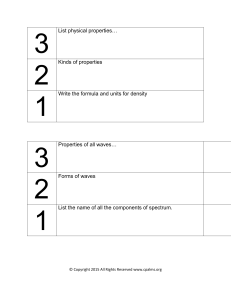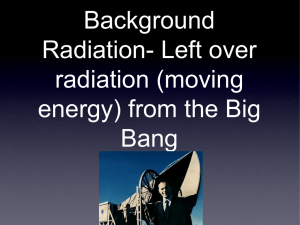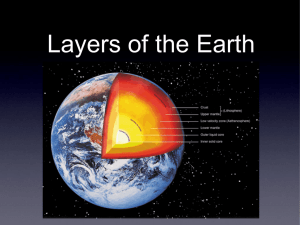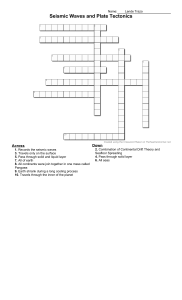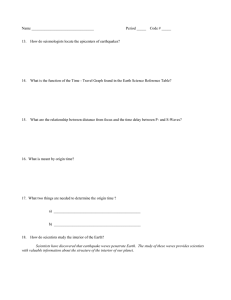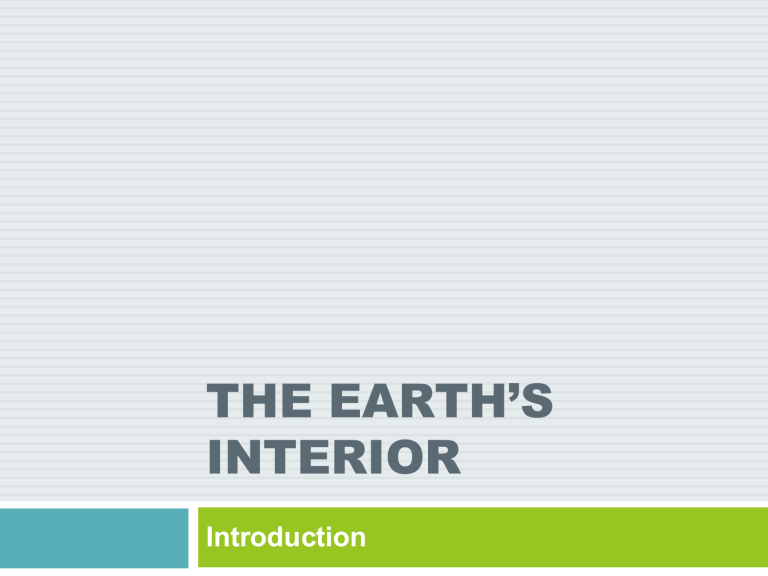
THE EARTH’S INTERIOR Introduction What to expect: This module will help you visualize and understand the composition and structure of the Earth’s interior. Key Questions: 1. How do the structure and composition of the Earth cause geologic activities and physical changes? 2. What are the possible causes of the lithospheric plate movements? 3. What proves the movement of the tectonic plates? Studying the Earth’s Interior Scientists tried to explore and study the interior of the Earth. Yet, until today, there are no mechanical probes or actual explorations done to totally discover the deepest region of the Earth. How did they know? The Earth is made up of three layers: the crust, the mantle, and the core. The study of these layers is mostly done in the Earth’s crust since mechanical probes are impossible due to the tremendous heat and very high pressure underneath the Earth’s surface. Reading Resources and Instructional Activities Read the given resources and answer Act. 1. Activity 1A: Amazing Waves! Objectives: Define seismic waves scientifically. Differentiate the different types of seismic waves. Recognize the importance of seismic waves in the study of the Earth’s interior. Procedure: (1whole) Construct your own organizer that shows necessary information and summarizes the concept about seismic waves. Answer Q1 and Q2. Seismic Waves Seismic waves from earthquakes are used to analyze the composition and internal structure of the Earth. What are seismic waves? Seismic waves Earthquake is a vibration of the Earth produced by the rapid release of energy. This energy radiates in all directions from the focus in the form of waves called seismic waves. Seismic Waves The energy that radiates in all directions from the focus of an earthquake. Wave Direction Epicenter Fault Focus Types of Seismic Wave Surface waves Body Waves Surface Waves can only travel through the surface of the Earth 2 Types of Surface Waves Love Waves Rayleigh Waves Love Wave named after A.E.H. Love, a British mathematician who worked out the mathematical model for this kind of wave in 1911. faster than Rayleigh wave it moves the ground in a side-to-side horizontal motion, like that of a snake’s causing the ground to twist cause the most damage to structures during an earthquake. Love Wave Rayleigh Wave named after John William Strutt, Lord Rayleigh, who mathematically predicted the existence of this kind of wave in 1885 wave rolls along the ground just like a wave rolls across a lake or an ocean up and down or side-to-side similar to the direction of the wave’s movement shaking felt from an earthquake Rayleigh Wave Body waves can travel through the Earth’s inner layers they are used by scientists to study the Earth’s interior higher frequency than the surface waves Body waves 2 types P-Waves (Primary waves) S-waves (Secondary waves) P-waves (Primary) is a pulse energy that travels quickly through the Earth and through liquids travels faster than the Swave it reaches a detector first P-waves (Primary) compressional waves, travel by particles vibrating parallel to the direction the wave travel move backward and forward as they are compressed and expanded they travel through solids, liquids and gases S-waves (Secondary/Shear) pulse energy that travels slower than a P-wave through Earth and solids Move as shear or transverse waves, and force the ground to sway from side to side, in rolling motion that shakes the ground back and forth perpendicular to the direction of the waves S-waves (Secondary/Shear) cannot travel through any liquid medium led seismologists to conclude that the outer core is liquid Seismic Waves movement Cross section of the Earth as seismic waves travel through it Propagation of Seismic Waves Through Earth’s Interior Longitudinal waves travel through both solids and liquids. Transverse waves travel through solids only. OUR HOME PLANET, EARTH Our Earth is about average among the planets in the Solar System, in many respects: and most massive of the four terrestrial planets, but smaller and less massive than the four giant, or Jovian, planets third in distance from the Sun among the four terrestrial planets has a moderately dense atmosphere; 90 times less dense than that of Venus but 100 times denser than that of Mars largest OUR HOME PLANET, EARTH Earth is also unique in many respects: the only planet with liquid water on its surface. the only one having a significant (21%) proportion of molecular oxygen to our best current knowledge, the only planet in the solar system having living organisms the only terrestrial planet having a moderately strong magnetic field the only terrestrial planet having a large satellite OUR HOME PLANET, EARTH The Composition of the Earth’s Interior Seismic Waves: Interior Part Did you know? The deepest mine in the world, the gold mine in South Africa, reaches a depth of 3.8km. But... You would have to travel more than 1,600 times that distance-over 6000km-to reach the earth’s center. DENSITY AND TEMPERATURE VARIATION IN DEPTH The Crust The Crust thinnest and the outermost layer of the Earth that extends from the surface to about 32 kilometers below Continental Oceanic Continental Continental Lithosphere Oceanic Moho Root Asthenosphere Stanley, 1989, p. 14 Stanley, 1989, p. 14 Continental mainly made up of silicon, oxygen, aluminum, calcium, sodium, and potassium mostly 35-40 kilometers found under land masses made of less dense rocks such as granite Oceanic oceanic crust is around 7-10 kilometers thick which its average thickness is 8 kilometers. found under the ocean floor made of dense rocks such as basalt heavier than the continental crust. The Crust: Continental • GRANITE -crystalline igneous rock composed primarily of quartz and feldspar. • forms from slowly cooling magma that is subjected to extreme pressures deep beneath the earth's. The Crust: Oceanic • BASALT -volcanic rock • forms from lava flows along mid-ocean ridges and also in igneous intrusions such as dikes and sills. • Columnar jointing, pictured here at Devil's Tower, Wyoming, occurs when molten basalt cracks as it cools, producing separate, polygonal fractures on the surface of the rock. Elements in the Crust Moho Discontinuity While studying the speed of earthquake waves, Croatian geophysicist Andrija Mohorovičić discovers a boundary between Earth's crust and mantle, which becomes known as the Mohorovičić, or Moho Discontinuity. The Mantle Beneath the crust is the mantle extends to about 2900 kilometers from the Earth’s surface about 80% of the Earth’s total volume about 68% of its total mass mainly made up of silicate rocks and contrary to common belief, is solid, since both S-waves and P-waves pass through it The Mantle mostly made of the elements silicon, oxygen, iron and magnesium lower part of the mantle consists of more iron than the upper part lower mantle is denser than the upper portion temperature and the pressure increase with depth high temperature and pressure in the mantle allows the solid rock to flow slowly Remember: The ability of the asthenosphere to flow slowly is termed as plasticity. crust and the uppermost part of the mantle form a relatively cool, outermost rigid shell called lithosphere (Gk.lithos means “stone”) and is about 50 to 100 kilometers thick Remember: Beneath the lithosphere lies the soft, weak layer known as the asthenosphere (Gk. asthenes means “weak”) made of hot molten material, about 300 – 800o C upper 150 kilometers has a temperature enough to facilitate a small amount of melting, and make it capable to flow facilitates the movement of the lithospheric plates lithosphere, with the continents on top of it, is being carried by the flowing asthenosphere. Layers The Core o 2000-5000 C core is subdivided into two layers: the inner the outer core. Outer Core 2900 kilometers below the Earth’s surface 2250 kilometers thick made up of iron and nickel temperature reaches up to 2000oC at this very high temperature, iron and nickel melt Outer Core Aside from seismic data analysis, the Earth’s magnetic field strengthens the idea that the Earth’s outer core is molten/liquid mainly made up of iron and nickel moving around the solid inner core, creating Earth’s magnetism The Inner Core made up of solid iron and nickel and has a radius of 1300 kilometers about 5000oC extreme temperature could have molten the iron and nickel but it is believed to have solidified as a result of pressure freezing, which is common to liquids subjected under tremendous pressure The Inner Core Aside from the fact that the Earth has a magnetic field and that it must be iron or other materials which are magnetic in nature, the inner core must have a density that is about 14 times that of water. Average crustal rocks with densities 2.8 times that of water could not have the density calculated for the core. So iron, which is three times denser than crustal rocks, meets the required density. Clues that the inner core and the outer core are made up of iron Iron and nickel are both dense and magnetic. overall density of the earth is much higher than the density of the rocks in the crust suggests that the inside must be made up of something denser than rocks Clues that the inner core and the outer core are made up of iron Meteorite analysis have revealed that the most common type is chondrite. Chondrite contains iron, silicon, magnesium and oxygen; some contains nickel. The whole earth and the meteorite roughly have the same density, thus the Earth’s mantle rock and a meteorite minus its iron, have the same density. HW5 Write a short story that describes the most exciting part of your own imaginary journey to Earth’s center. Bring the ff. (by group) scissors old magazines brown envelope


